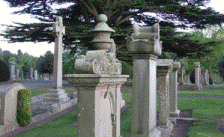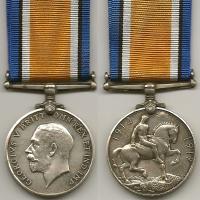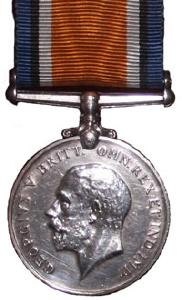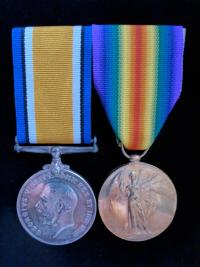- Award*: British War 1914-20 Medal was awarded to Alexander Miller chiropodist on 11 November 1918 British War Medal 1914-18
Victory Medal.3
- Award*: British War 1914-20 Medal was awarded to Walter Edward Adamson Neave steamship purser after 14 March 1919.1
- Award*: British War 1914-20 Medal was awarded to Edward Conway in 1920 British War Medal & Victory Medal.4
- Award: British War 1914-20 Medal was awarded to John Dickson confectioner & fruiterer on 28 January 1921 at Perth, Perthshire, Scotland,
 .5
.5 - Note for Web*: British War 1914-20 Medal The British War Medal was a campaign medal of the British Empire, for service in World
War I.
The medal was approved in 1919, for issue to officers and men of British and Imperial forces
who had rendered service between 5 August 1914 and 11 November 1918.
Officers and men of the Army (including colonial and dominion forces) were required to
have either entered an active theatre of war, or left the United Kingdom for service
overseas, between 5 August 1914 and 11 November 1918, and completed 28 days mobilised
service. The medal was automatically awarded in the event of death on active service
before the completion of this period. The same criteria were applied for eligibility for staff
of officially recognised non-military hospitals, such as those run by the Red Cross, and
members of the women's auxiliary forces.[1]
For the Royal Navy, Royal Marines, and the Dominion and Colonial naval forces, the criteria
was 28 days mobilised service, but without the requirement for overseas service. Again, the
medal was automatically given to the next-of-kin of casualties if they were killed before
the completion of this period. The medal was also awarded, with the same conditions, to a
number of non-Naval personnel serving on Royal Navy ships, such as canteen and medical
staff, and to members of the Women's Royal Naval Service.[1]
In the Royal Air Force, eligibility was broadly the same as for the Army - it required
overseas service. However, members of the RAF, RNAS or RFC who had seen combat whilst
based in the UK, who had ferried aircraft to France, or who had served on ships carrying
aircraft, were deemed eligible.[1]
The medal was later extended to cover the period 1919–20 and service in mine-clearing at
sea as well as participation in operations in North and South Russia, the eastern Baltic,
Siberia, the Black Sea, and the Caspian.[2]
Some 6,500,000 medals were awarded in total, of which 110,000 were bronze. These
bronze medals were mostly issued to Chinese, Maltese, and Indians who served in labour
battalions of such organizations as the Chinese Labour Corps.
Description
The medal is a circular silver (or, in rare cases, bronze) design. The obverse shows a
King George V bareheaded effigy, facing left, with the legend: GEORGIVS V BRITT :
OMN : REX ET IND : IMP : (George V, King of all the British Isles and Emperor of India)
The reverse shows St. George naked on horseback, armed with a short sword (an
allegory of the physical and mental strength which achieves victory over Prussianism).
The horse tramples on the Prussian shield and the skull and cross-bones. Just off-centre, near the right upper rim, is the sun of
Victory. The dates 1914 and 1918 appear in the left and right fields respectively.
The ribbon has a wide central watered stripe of orange, flanked by two narrow white stripes, which are in turn flanked by two black
pin-stripes, further flanked by two outer stripes of blue. The colours are not believed to have any particular significance..6 - Note for Web: British War 1914-20 Medal Established on 26th July 1919.
The Front of the British War Medal, 1914-18 (Squeak)
Also known as 'Squeak'.
The silver or bronze medal was awarded to officers and men of the British and Imperial Forces who either entered a theatre of war or entered service overseas between 5th August 1914 and 11th November 1918 inclusive. This was later extended to services in Russia, Siberia and some other areas in 1919 and 1920.
Approximately 6.5 million British War Medals were issued. Approximately 6.4 million of these were the silver versions of this medal. Around 110,000 of a bronze version were issued mainly to Chinese, Maltese and Indian Labour Corps. The front (obv or obverse) of the medal depicts the head of George V.
The recipient's service number, rank, name and unit was impressed on the rim..7 - (Witness) Note for Web: British War 1914-20 Medal and Allied Victory 1914-19 Medal, Territorial Force War, 1914-1919 Medal, Silver War Badge Medal and Mercantile Marine War Medal were mentioned with 1914 Star Medal and 1914-15 Star Medal. There were five campaign medals available for individuals who saw service in the First World War. An individual, male or female, could be issued with a maximum of three of these medals, although there are a small number of exceptions to the rule.
Service medals were issued automatically to other ranks, but officers or their next of kin had to apply for them. Medals were impressed with the name of the recipient and usually included some or all of the following: service number, rank, first name or initial, surname and military unit (Regiment or Corps). This was either on the rim of the medal or in the case of a star, on the reverse.
In addition to the five campaign medals a badge was available to officers and men who had been honourably discharged or had retired as a result of sickness or wounds from war service.
British Campaign Medal Sets
The 1914 Star
The 1914-15 Star
The British War Medal, 1914-18
The Allied Victory Medal
The Territorial Force War Medal, 1914-1919
The Silver War Badge
Mercantile Marine War Medal.7 - (Witness) Note for Web: British War 1914-20 Medal and Allied Victory 1914-19 Medal were mentioned with 1914 Star Medal and 1914-15 Star Medal. Pip, Squeak and Wilfred
Three of the British campaign medals: The 1914-15 Star, British War Medal and the Victory Medal. Three of the British campaign medals: The 1914-15 Star, British War Medal and the Victory Medal.
Pip, Squeak and Wilfred are the affectionate names given to the three WW1 campaign medals — The 1914 Star or 1914-15 Star, British War Medal and Victory Medal respectively. These medals were primarily awarded to the Old Contemptibles (B.E.F.) and by convention all three medals are worn together and in the same order from left to right when viewed from the front. The set of three medals or at least the British War Medal and the Victory Medal are the most likely medals to be found among family heirlooms.
Book cover of Pip Squeak and Wilfred
When the WW1 medals were issued in the 1920's it coincided with a popular comic strip published by the Daily Mirror newspaper. It was written by Bertram J. Lamb (Uncle Dick), and drawn by the cartoonist Austin Bowen Payne (A.B. Payne). Pip was the dog, Squeak the penguin and Wilfred the young rabbit. It is believed that A. B. Payne's batman during the war had been nicknamed “Pip-squeak” and this is where the idea for the names of the dog and penguin came from. For some reason the three names of the characters became associated with the three campaign medals being issued at that time to many thousands of returning servicemen, and they stuck.
“Mutt and Jeff”
The two British campaign medals commonly found as family heirlooms nicknamed Mutt and Jeff: the British War Medal and the Victory Medal. The two British campaign medals: the British War Medal and the Victory Medal.
In a similar vein when only the British War Medal and Victory Medal are on display together they are sometimes known as “Mutt and Jeff”.7 - [S54] Website findmypast.co.uk (www.findmypast.co.uk) British Army Service records 1914-1920 transcription
Series WO 363
Record set British Army Service Records 1914-1920
Category Military, armed forces & conflict
Subcategory First World War
Collections from Great Britain
URL of this page: http://search.findmypast.co.uk/record?id=gbm%2fwo363-4%2f7276392%2f9%2f204 [April 2016]. - [S49] Website Web Site online (www.) https://www.gov.uk/guidance/medals-campaigns-descriptions-and-eligibility#world-war-2-medals [Sept 2021].
- [S43] PCC / DJAA.
- [S9] Website Ancestry.co.uk (www.ancestry.co.uk)
UK, WWI Service Medal and Award Rolls, 1914-1920 for Edward Conway
British War Medal and Victory Medal
Scottish Rifles (Cameronians) [Aoril 2020]
Piece 1120: Scottish Rifles (Cameronians). - [S126] Website The National Archives (of the UK) (http://www.nationalarchives.gov.uk/help-with-your-research/research-guides/?letter=&search=&research-category=online) this via Facebook member Bryan Johncock on UK Military Genealogy and Photograph Identification Group; 1917 John Dickson medal roll [April 2017].
- [S29] Wikipedia.
- [S49] Website Web Site online (www.) http://www.greatwar.co.uk/medals/ww1-campaign-medals.htm [Oct 2021].
British War 1914-20 Medal1,2
?, #13650
Last Edited: 8 May 2022
 Genes on the Web
Genes on the Web


